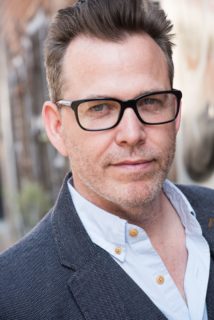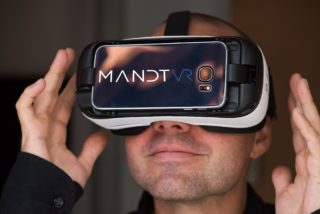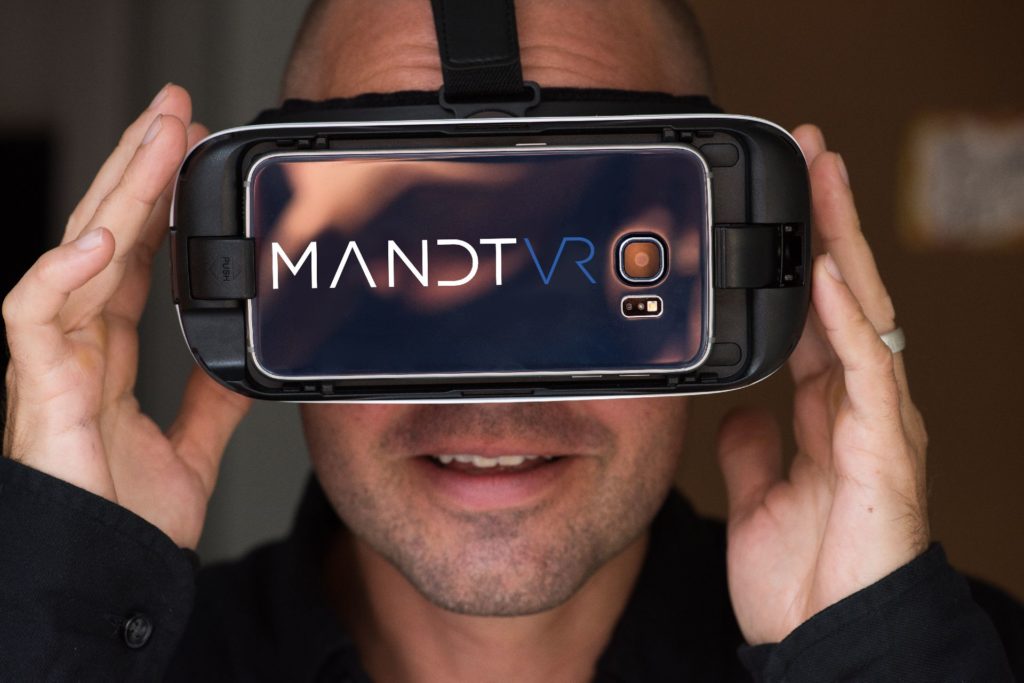Mandt VR is a new production company with the ambitious goal of creating high-quality, volume, serialized, virtual reality 360 content. Its 360-degree video shows cover a variety of topics, including a romantic drama called Single in the City—about a woman dating in the digital age—and a series featuring Pokémon GO.
The company’s founder and CEO is the Emmy-award winning TV and film producer, Neil Mandt, who speaks to [a]listdaily about creating and promoting serialized VR content and what challenges are still ahead.

What platforms can Mandt VR content be found on?
Right now, we’re publishing on YouTube 360, Facebook 360 and Littlstar—we entered into a partnership with Littlstar to distribute all of our content. Down the line, who knows whether or not we may have a platform of our own in some capacity? But for right now, our mission is to create content and push it out on other platforms.
What differentiates Mandt VR content from what’s available now?
There are actually two divisions of our company. One of the divisions is a pretty straightforward work-for-hire agency, where people come and ask us to make content for them. That’s pretty simple business.
On the other side of the company, we’re leading the path to serialized content. At this point, there’s very little serialized content that exists anywhere in VR. It’s a lot of tech demos and brand experiences, but there aren’t ten episodes of a series. Mandt VR saw that opportunity, and this last August, we began creating serialized shows. We’re currently in production on over twenty different shows, and each show has a minimum of ten episodes. That’s 200 episodes of serialized content, which—to my knowledge—doesn’t exist anywhere.
What are some of these projects?
Our content is broad. We have a news division that is creating multiple videos per week. That’s led by George Sells, who is a 25-year veteran of local news reporting. Then we are creating dating shows, food shows, travel shows and sports shows. There are also gaming shows—we did a whole series on Pokémon GO. Several of our shows are available on our YouTube channel right now.
One of our bigger projects, which is a massive undertaking, is the partnership we just engaged with PodcastOne. Norm Pattiz created Westwood One and developed that into a massive radio network. He went around to individual podcasters, the top of the top. He collected 200 podcasters, who range from Adam Carolla (who has the most downloaded podcast in the Guinness Book of World Records) to Shaquille O’Neal, to The Housewives—a wide variety of talent. They produce 200 podcasts per week, which equals 450 hours of content. Last year, PodcastOne content had 1.5 billion audio downloads. They don’t have a video presence, and Mandt VR has signed an exclusive contract with them to produce all their podcasts in virtual reality.
For perspective, a cable network like History Channel, A&E or Discovery Network will produce 450 hours of original content in one year. We will be producing 450 hours of content in VR per week. That’s 23,000 hours of VR content per year, and that’s just one channel of our vertical.
About how long are these shows?
The shows we’re doing right now are short form; they’re about 12 minutes. Our other shows are between three and seven minutes. It’s primarily short form content, but in less than a year’s time, we will be moving to streaming all the podcasts live in their full run. So, they’ll be hour or two-hour long shows.
What are the challenges of creating this volume of content in such short time?
The first challenge is quality, and that is the most important thing. I was reading that a lot of the quality in VR right now stinks, and I agree with that. I think there is a serious lacking in quality. There’s a reason for that, and I really understand it, and I think this is where we’re separated from a lot of the people who are just getting into the space. Mandt VR is comprised of a group of award-winning producers and directors who have a long history in creating content.
Personally, I have a background, having produced over 3,000 hours of television, produced or directed over half a dozen movies, and countless digital projects. I come from the storytelling medium, and my entire staff is the same. Where a lot of people who are dipping their toe in the VR world tend to be from a tech background and not necessarily storytellers. No matter what their product is, there’s a lot that’s lacking because they don’t come from a storytelling experience.
How are you promoting these shows, and how does it differ from promoting a traditional digital program?
We’re really in the infancy of that right now. What we’re doing today, and what we’ll be doing in the next couple of years will be changing. Right now, our focus is on promotion through partnerships. For example, there’s the PodcastOne partnership. They will be promoting it across their platform. So, as we’re creating content with partners, we’re looking for promotion with someone that we can work with to put the message out.
Our show, Don’t Eat This—one of the stars of the show is one of the top 100 Instagramers, according to Rolling Stone magazine. So, he’s pushing out. We push out through social media and traditional media, but we look to have partners who have a voice that are going to be heard.
What do you think is the adoption rate for VR, for both premium and mobile headsets?
I would say that the adoption rate is just above zero percent. It’s very low right now. The majority of the people I encounter when I’m talking about VR, outside of VR enthusiasts, have heard of it but haven’t touch a pair of goggles and have not had an experience. I see this next year as the beginning of that shift. I think PlayStation VR was a seminal moment, getting VR into homes with families, where kids can then educate their parents and older siblings and friends on the VR experience. I think we’re going to see a ramp up in the adoption rate in 2017, but we won’t see mass adoption until 2018.
Mandt VR is playing for the long haul. We’re creating content now that has limited monetizational abilities—and will have a limited reach—but knowing that as the adoption rate grows that there will be a lack of content and Mandt VR can fill that hole by having volume serialized content for people to watch.
What differentiates Mandt VR from companies like Jaunt VR?
I’m incredibly excited about other companies who are in this space in a meaningful way, and Jaunt is a company like that. I’m a fan of their work. What differentiates us from them is that the content we’re creating has been mostly created internally by our staff of professional storytellers. Where Jaunts seems to have a broader mission of not only creating content, but having a platform on day one, as well as creating tech and camera equipment. Mandt VR is only focused on one thing, which is creating high volume, very good quality serialized content.
Mandt VR is additionally looking to move beyond PodcastOne to create other live content in the music, sports and news space. So, we are moving towards a livestreaming network very soon.
Mandt VR is currently focused on short form content, but do you think that audiences will be able to engage with longer experiences in the near future?
Yes, I do. In fact, Mandt VR has already begun the early production of a talk show with a marquee host. That show will be 30 minutes long, it will have a live studio audience, it will be produced in the Mandt VR studio here in Hollywood and it will also be cut down by segments for more consumable viewership. However, there will be a 30-minute version of the show that will be distributed, and we’re in talks with Google about potentially launching that with Daydream.

With both PlayStation VR and the Pixel Phone (Daydream) out now, what challenges remain for the mass adoption of VR?
The challenges are having people who have real production background getting into the space and creating quality content. The biggest problem that VR faces right now is bad content—that is something that can turn people off. So, right now, I think we need to have more companies creating content that is serialized and professionally produced.
That will happen over time. If you think about the growth of the internet, or the growth of the mobile phone and mobile content, we went through this all before. We have websites from the ‘90s that are terrible, and the reason was because the person who was making the website had a tech background and was able to make the tech exist, but they didn’t have the story. Over time, we got more people involved in the creation of creative content who had a storytelling background and things got a little smoother. That is what is going to happen with VR.
In the short term, I think the leading players are going to be in the gaming space because they have developed storytelling that works well with these devices. They just have to enhance it into a 360 sphere. Adoption will happen first and foremost with gaming, and it will grow over time, as goggles become less bulky. It’s going to be a combination of storytelling experiences and changes in hardware that make it more comfortable. All of this will happen between now and 2018.
It’s been argued that the only way to appreciate good content is to have bad content. What are your thoughts on that?
I would agree with that. I do think that bad content helps you appreciate good content. But my observation right now is that there is very little good content and virtually no good serialized content. That’s where we are trying to make our mark. It’s a wide-open space. If you see a show, like it, and want to watch more, you can’t because everyone is doing these one-off demos. That’s in large part because of costs. It takes time and it’s laborious to stitch these products. At Mandt VR, we have 40 people who are only doing virtual reality. We have made a significant investment to produce this content, and as a result of having this team, we were able to create an assembly line setup to bring the costs down and create more content.
If you look at it from a business perspective, many people ask if it’s too soon to do that because you cannot monetize at this point. I say, I’d rather be a leader than be last. That is our play.

